Hotrod Gear?
A Very Light Mandolin Bridge
© Frank Ford, 3/29/99; Photos by FF, 3/24/99
I'd like to take a moment to introduce you to my mandolin bridge. About 25 years
ago, I started playing around with different bridge designs and came up with a simple
and not very original observation: If you make the bridge lighter, you'll get more
volume, especially in the bass (I think). The only thing was that I had to make a
really significant decrease in mass before it was obvious enough for me.
Let me show you the results of my simplest and most effective experiment.
First, I'll weigh a standard adjustable bridge.
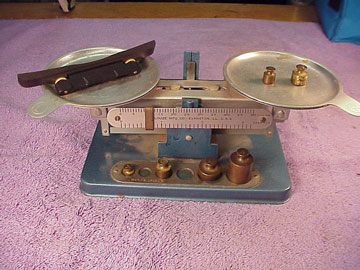
This ebony bridge measures 15.6 grams.
I've had this little balance since I was in high school in the late 1950s. It
ain't much, but it will discriminate down to about 0.10 gram, certainly accurate
enough for the kind of work I do.
Now, my light bridge:

Only 3.7 grams! Now that's the kind of difference that makes a difference.
Conventional wisdom holds that if you have an adjustable bridge and change from large
adjusting screws to small ones, you're supposed to be able to hear an increase in
volume because you've reduced the total mass of the bridge. Sometimes it's a little
difficult to hear those small "improvements" because they're subtle in
their effects. But, reduce the bridge mass by more than 75 percent, and you'll be
sure to hear it.
Why? It's a simple matter, really. Add mass to the bridge, and you make it more
difficult for the string to move the bridge because of increased inertia. Then the
string vibrates, dissipating more of its energy toward the peghead. The effective
difference in tone is a reduction of volume, longer sustain, and reduced bass. Test
this anytime by touching a heavy weight like a ceramic coffee mug against the bridge
of an instrument and listening to the difference in sound.
That's the way mutes work. They add mass to the bridge, impeding its vibration.
Speaking of mutes, here's another way to look at my light mandolin bridge. It weighs
so little that even adding THREE violin mutes, it's still lighter than the conventional
adjustable bridge:
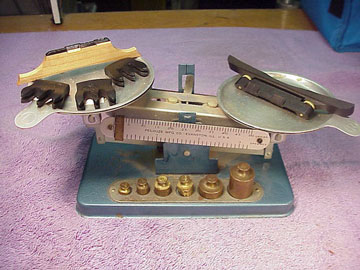
Here it is up close:
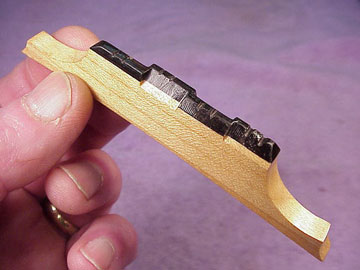
It's a hard maple bridge with an ebony cap.
And here's why it weighs so little:
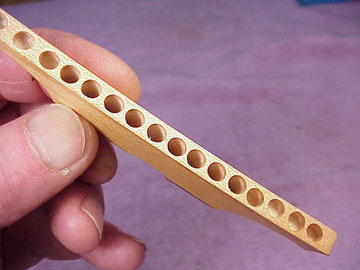
This thing is really a honeycomb shell with an ebony lid. I drilled it out from the
bottom after it was completed, just to get it as light as possible without compromising
its ability to handle that vertical load of the string tension.
Here it is in place, on the mandolin I made in 1971:
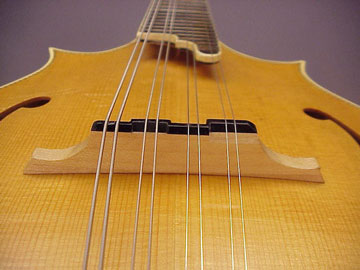
Over the years, I've switched back and forth between this bridge and the conventional
ebony adjustable bridge. There's no mistaking the volume and tonal difference
between the two, but that doesn't make one better than the other. I must admit
that I like the adjustable tone better on this f-hole style mandolin, even though
using that bridge makes the instrument considerably quieter. The folks I've played
with over the years have made it clear that they'd rather hear the extra volume
of the light bridge, so that's the one I use.
So, what could I do? Naturally, I used this kind of reasoning to justify buying another
mandolin (or two, or three. . .)
Over the years, I've been asked to make this kind of bridge for various instruments,
and I've found it has a greater effect on the lighter and more responsive
tops of high quality handmade mandolins.
One down side is, of course, the cost and trouble of such an installation.
The bridge must be made and fitted while the instrument is in the shop,
and these days our shop is so busy with local work we can't take jobs by
shipment.
Back to Index Page





